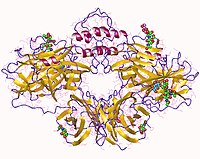
Photo from wikipedia
Polydopamine (PDA) is considered as a fluorescent molecule, however, the molecular structure and degree of polymerization that yield the most efficient fluorescence have yet to be identified. Here, we first… Click to show full abstract
Polydopamine (PDA) is considered as a fluorescent molecule, however, the molecular structure and degree of polymerization that yield the most efficient fluorescence have yet to be identified. Here, we first present the fluorescence origin of polymerized dopamine derivatives (pDA) and their extraordinary behavior on the ultra-selective recognition of Fe2+ ions. Dopamine molecules are polymerized to 5,6-dihydroxyindole-rich pDA in basic conditions, followed by readily oxidizing to indole-5,6-quinone-rich pDA by dropping the pH to strongly acidic conditions. It was clearly demonstrated that oligomeric dopamine molecules were water-soluble with intense fluorescence (F-ODA, n = 3–4), while polymeric dopamine molecules were water-insoluble without fluorescence (PDA, n > 5). Also, F-ODA was dramatically selective to Fe2+ ions contradicting previous studies, and their unique binding mechanism was described through the redox potential analysis.
Journal Title: RSC Advances
Year Published: 2017
Link to full text (if available)
Share on Social Media: Sign Up to like & get
recommendations!